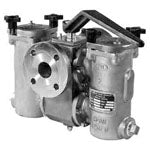Keeping process cooling fluids clean requires a filtration strategy – this could include a strainer, filter, or a combination of both. Below are several options for cleaning process cooling fluids. Selecting a filtration strategy for process cooling fluids can be as challenging as developing the right type of filter to use in your manufacturing plant. We will explain some options available and how mechanically-cleaned filters might help provide an optimal solution when used with process cooling applications.
Should You Have a Strainer or Filter for Your Process System?
A strainer separates the larger particles from smaller ones. A filter can remove even finer particulate matter, such as bacteria, viruses, and other microscopic contaminants which may be harmful or not accessible by strainers. The general rule of thumb is: “If you can see it, then you can strain it!” A simple strainer can effectively remove articles in the 75 to 100 micron and 200 to 150 mesh range.
If you’re using a strainer or filter, it needs to be cleaned periodically. If the media is made of wire mesh, then you can shut down the flow and remove what has been trapped in there. For filters that use a bag-like material, like polyester weave cloths, they are maintained in much the same way. However, these filters are for more complex materials with finer holes such as paper pulp screens.
Regardless of whether a strainer or filter is used, particles need to be removed from time to time because buildup will happen over prolonged periods of time. A successful solution may need two types of technology: strainers and filters. While this may require expensive initial investment, it will result in excellent performance over time if used according to the plan laid out for them.
Types of Strainers and Filtration Systems for Process Cooling
Basket strainers are installed upstream of equipment like pumps, control valves, and traps, keeping potentially corrosive or damaging debris from making its way down the line. They can be installed alone or in a series to increase filtration. They may come with a single chamber (simplex strainers) or multiple chambers (multiplex strainers).
Industrial filter housings are designed to hold bags or cartridges. Some are even designed so the user can switch between the two. Filter bags use a fine mesh to remove unwanted debris and particles from the media in a system. They have a plastic or metal ring at the top to hold them securely in the housing, and the bag itself is usually made from cloth or plastic.
Filter cartridges are used in industrial filtration when high purity is necessary. They are able to filter out particles that would pass through a traditional filter bag. One example of filter cartridges on a consumer level are drinking water filters in sinks and pitchers. In the commercial/industrial sectors, cartridge filtration is used in a wide range of industries, including food & beverage, industrial water treatment, cosmetics, and pharmaceuticals. In short, any application that requires a high degree of purity would be benefited by filter cartridges.
Sand media filters are designed for the demands of cooling tower operations. They remove down to 5-micron particles, but they require a lot of space and maintenance as well. They have low maintenance requirements, but when they do need to be serviced it can take a lot of time because they require more manpower than other options. This is why many use them as backup or supplementary filtration for high volume applications that requires reliability in load variations like backwashing.
A common problem with industrial filters is that they need to be cleaned manually. Leaving a filter without water flow for an extended period of time can lead to various issues, including the buildup and clogging of sediment or particles in the system – not ideal! Luckily, there are two types of self-cleaning filters, which help keep your business running smoothly. One comes as part of a complete cartridge/element assembly. The other, however, takes on more than the other self-cleaning filter’s responsibility by also providing protection against particulate matter being released into the environment during maintenance periods (although it does require manual cleaning).
Automatic self-cleaning filters use a rotating hollow internal arm to collect debris deposited on the filter media. When more and more particles are trapped against it, the pressure drop through your water supply increases until it reaches a pre-determined value. At that point, valves open up letting fluid out of your system – carrying accumulated dirt with them. Learn more about how self-cleaning filters work here.
A mechanical self-cleaning filter is vacuum-sealed at the top, and a circular disc with blades inside scrapes off debris from the media. The pressure drop increases as trapped particles build up, so when enough dirt has built up to raise the pressure by about 10% of what's needed, an actuator activates and a little vortex sweeps up all these small pieces while they're still traveling horizontally! Once there, their momentum changes direction, so now they fall straight down below where any other removed material goes after landing on its own scraper plate.
Cooling Water Filter Applications
Water from cooling tower applications attracts and absorbs airborne contaminants on a continuous basis, contributing to the excessive creation of deposits (scale, corrosion, fouling). These deposits lead to a reduction in heat transfer efficiencies. The increased operating costs are caused by scale buildup, among other factors that increase maintenance expenses. Many of the industries that use cooling water filters are food & beverage, healthcare, pharmaceutical, power generation, and refining & chemicals.
Choose Your Process Cooling Fluid Strategy
Now you’re familiar with several filtration strategies for process cooling fluids. Choose the right strainer, filter, or a combination of both for your application. Take a look at some of the products we offer: browse strainers, cartridges, housings, and shop filter bags today.

